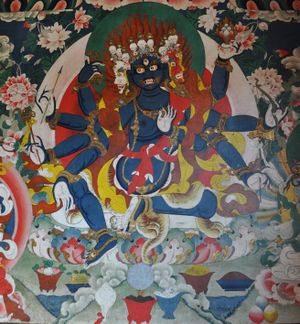Dorje Dermo

Dorje Dermo (Skt. vajraṇakhī; Tib. རྡོ་རྗེ་སྡེར་མོ་, dorje dermo, Wyl. rdo rje sder mo; Eng. Vajra Claw) — a wrathful female activity dakini. Within the Vajrakilaya tradition she is the consort of Niladanda of The Ten Wrathful Ones. Her name translates as Vajra Claws into English and may be restored in Sanskrit as Vajra Nakhi. Her mantra has a long history and can be found in a variety of forms in the Guhyasamaja, the Vajravarahi, and the Vajrakilaya traditions. In this context Dorje Dermo’s mantra is recited in connection to the ritual of the liberation of obstacles. Over time and especially within Tibet, Dorje Dermo became a deity independently invoked as to protect the practitioners’ domestic space, their family, their friends and their allies and to avert any obstacles that might threaten them.[1]
History
According to The Incantation of Glorious Vajra Claws, the Buddha revealed the method for invoking Dorje Dermo in a place called the Vajra Palace (Wyl. rdo rje zom gyi kham) to an assembly of monks and tantric practitioners. There the Buddha advised them, that if the dharani is recited, Dorje Dermo will become their guardian and protector, they will obtain many qualities and encounter only favourable circumstances.
At the end of the dharani, Dorje Dermo recounts that countless aeons ago she took birth as a female practitioner. At that time the buddha called Dridha-shura-sena-prabha-raja (Skt. Dṛḍhaśūrasenapraharaṇarāja; Wyl. dpa’ brtan pa’i mtshon cha’i rgyal po) visited the world. When Dorje Dermo met this buddha, he placed his hand upon her head and entrusted her with the dharani. He foretold her that if she continuously recites the dharani, in future she will become known as the deity Dorje Dermo and bring great benefit and happiness to all sentient beings.
Texts
The main text invoking Dorje Dermo as an independent deity is entitled The Incantation of Glorious Vajra Claws. The dharani, although attributed to Buddha Shakyamuni, is not found in any of the extant Kangyur and Tengyur versions. The text is independently preserved in various Tibetan Dharani collections.[2] This and other reasons[3] suggest that this dharani is a Tibetan composition or revelation. In addition, there are several short practices written for daily recitation, such as a condensed form of the long dharani composed by Karma Chakme[4] and a short practice arranged by Dilgo Khyentse Rinpoche based on a terma revelation by Chokgyur Dechen Lingpa.[5]
- The Incantation of Glorious Vajra Claws (Skt. śrīvajraratirunāma ḍhāraṇī;[6] Tib. དཔལ་རྡོ་རྗེ་སྡེར་མོའི་གཟུངས།, Tib. dpal rdo rje sder mo'i gzungs).
- English translation: The Dharani of Glorious Vajra Claws, Joan Nicell (Getsulma Tenzin Choden) together with Venerable Geshe Jampa Gyatso, in The Dharani of Glorious Vajra Claws (Dorje Dermo), Foundation for the Preservation of the Mahayana Tradition, 2008.
Sources
- dpal rdo rje sder mo'i gzungs
- karma chags med, dpal rdo rje sder mo bsdus pa'i gzungs
- bkra shis dpal 'byor, zab bdun cha lag las kyi mkha' 'gro rdo rje sder mo'i rgyun khyer rdo rje'i go cha
References
- Griffiths, Arlo. “Written traces of the Buddhist past: Mantras and Dhāraīs in Indonesian inscriptions.” In Bulletin of the School of Oriental and African Studies, 77, 214: 137-194.
- Lama Zopa Rinpoche. Advice on how to Practice Vajra Claws (Dorje Dermo)
- Mayer, Robert and Cantwell, Cathy. “The Dunhuang Phur pa Corpus: A Survey”, in Almogi, Orna, ed. Contributions to Tibetan Buddhist Literature. PIATS 2006: Tibetan Studies: Proceedings of the Eleventh Seminar of the International Association for Tibetan Studies, Königswinter 2006. Beiträge zur Zentralasienforschung 14. Halle: International Institute for Tibetan and Buddhist Studies, 2008: 248-276.
- Mayer, Robert and Cantwell, Caty. Early Tibetan Documents on Phur Pa from Dunhuang. Verlag der Österreichischen Akademie der Wissenschaften, 2008: 84-5.
- Sanderson, Alexis. Atharvavedins in Tantric Territory: The Āngirasakalpa Texts of the Oriya Paippalādins and their Connection with the Trika and the Kālīkula, with critical editions of the Parājapavidhi, the Parāmantravidhi, and the *Bhadrakālī-mantravidhiprakarana.” In: The Atharvaveda and its Paippalāda Śākhā: Historical and Philological Papers on a Vedic Tradition, edited by Arlo Griffiths and Annette Schmiedchen. Aachen: Shaker Verlag, 2007. Geisteskultur Indiens: Texte und Studien, 11, Indologica Halensis: 195-311
Notes
- ↑ Robert Mayer and Cathy Cantwell, “The Dunhuang Phur pa Corpus: A Survey”, in Almogi, Orna, ed. Contributions to Tibetan Buddhist Literature. PIATS 2006: Tibetan Studies: Proceedings of the Eleventh Seminar of the International Association for Tibetan Studies, Königswinter 2006, Beiträge zur Zentralasienforschung 14, (Halle: International Institute for Tibetan and Buddhist Studies, 2008), 258-9.
- ↑ The Dharani is also found as a Tibetan text within a collection of rare Mongolian manuscripts (http://eap.bl.uk/database/results.a4d?projID=EAP031) and among the Kawaguchi Ekai Collection of Tibetan texts brought to Japan (http://124.33.215.236/Database/KawaguchiTop-e.html)
- ↑ Such as the mentioning of names and places uncommon to the broader Dharani literature that do not appear to have an Indian origin. The non-matching Tibetan and Sanskrit title. And, the absence of a translators colophon.
- ↑ karma chags med. "dpal rdo rje sder mo bsdus pa'i gzungs/." In gsung 'bum/_karma chags med/ (gnas mdo dpe rnying nyams gso khang /). TBRC W1KG8321. 34: 217-218. [nang chen rdzong]: gnas mdo gsang sngags chos 'phel gling gi dpe rnying nyams gso khang /, [2010]. http://tbrc.org/link?RID=O1KG8321%7CO1KG8321C2O1430$W1KG8321
- ↑ bkra shis dpal 'byor. "zab bdun cha lag las kyi mkha' 'gro rdo rje sder mo'i rgyun khyer rdo rje'i go cha/." In gsung 'bum/_rab gsal zla ba. TBRC W21809. 9: 537-542. delhi: shechen publications, 1994. http://tbrc.org/link?RID=O2DB57601%7CO2DB576012DB60091$W21809
- ↑ This dharani gives the following Sanskrit title. However, how the Sanskrit title relate to the Tibetan title is unclear. The Tibetan word Dorje Dermo could be reconstructed into Sanskrit as Vajraṇakhā or Vajraṇakhī, but Vajraratī can not be translated into Tibetan as Dorje Dermo. Vajraratī is a goddess which figures in a number of tantras. She is the consort of Amoghasiddhi and one of the five Ratis (the other four being Dveṣaratī, Moharatī, Rāgaratī, and Īrṣyāratī).